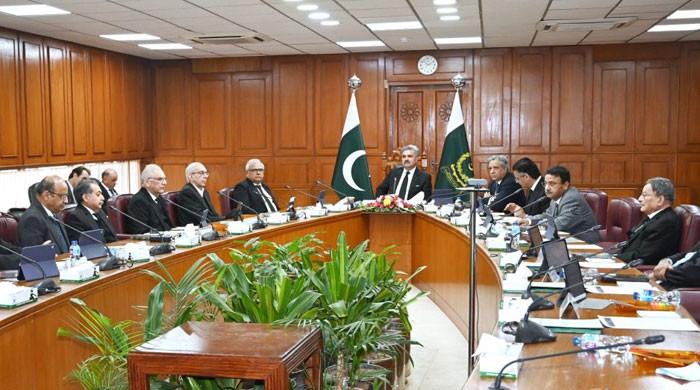Finance Ministry points out key risks to Pak economy
Ministry says inflation rate has been volatile for few years, due to various factors that include currency devaluation
February 22, 2024

- SBP actively responding to increasing inflation by raising policy rate.
- There is a heightened risk to external stability.
- Inflation outlook has deteriorated.
ISLAMABAD: In a report by the Ministry of Finance eight important factors related to financial risks have been highlighted that it believes can aggravate Pakistan’s economy, reported The News on Thursday.
The key factors are identified as macroeconomic imbalances, rising debt, guarantees, climate degradation, state owned enterprises (SOEs) losses, public-private partnership risks, provincial government’s fiscal indiscipline and governance challenges.
The Ministry of Finance in Fiscal Risk Statement (FRS) for 2023-24 said that in Pakistan, the inflation rate had been volatile the last few years, due to various factors that include currency devaluation, energy, and food prices in the global market.
The Pakistani rupee has experienced significant depreciation in recent years, influenced by various risk factors such as trade imbalances, external debt, political instability and global economic conditions. The State Bank of Pakistan (SBP) is actively responding to increasing inflation by raising the policy rate. Moreover, the government is also focusing on taking effective policy, administrative, and relief measures to control inflation and stabilise the economy, the FRS said.
The inflation outlook has deteriorated, and there is a heightened risk to external stability. The uncertainty surrounding the future adjustment path in energy prices is the main upside risk to the inflation outlook. However, a potential moderation in international commodity prices may contribute to a reduction in inflation. Further, exchange rate adjustments, passing on the impact of energy price increases, and interest rates on the higher side would enable the prices to decline over the medium term. Subsequently, it would follow the expansionary monetary policy and improvement in fiscal space given the decline in mark-up payments. As such, the stabilisation measures taken during the last year can bring macroeconomic and fiscal benefits in the medium term.
The government aims to reduce the fiscal deficit by implementing measures such as expanding the tax net, rationalising subsidies, and promoting economic growth. However, the challenge of rising debt servicing could hinder the reduction of the fiscal deficit. Three scenarios (depicting macroeconomic risks) are simulated to analyse fiscal risks. Scenario 1 projects/ simulates the reactions of revenues, expenditures, and fiscal deficit in a situation where the government can have access to low-cost availability of financing options (reduction of 2 percentage points of interest rate on external debt and 4 percentage points in domestic currency interest rate).
It is expected that the net federal revenues will remain at 6.7% of GDP, federal expenditures will eventually reach 9.7% of GDP whereas federal fiscal deficit will touch 3.0% of GDP.
The scenario 2 elaborates the responses of revenues, expenditures, and fiscal deficit to reduction of 50% in non-tax revenues against baseline projections. The net federal revenues will decrease to 5.3% of GDP, federal expenditures will remain at 10.6% of GDP, and federal fiscal deficit will increase to 5.4% of GDP.
The scenario 3 highlights the reactions of revenues, expenditures, and federal fiscal deficit if growth rate remains below the projected rate by 0.5% every year in the medium term. By FY2026, the net federal revenues, federal expenditures, and federal fiscal deficit will remain at 7.1%, 11.0%, and 3.9% respectively. Federal fiscal deficit is more sensitive to low non-tax revenue collections than decrease in interest payments or GDP.
Over the last five years, total public debt of the government has exceeded the prescribed limit of 60% of GDP under the FRDL Act. This is primarily due to consistent fiscal deficits, averaging 6% of GDP since 2010, which have led to a rapid build-up of debt. The debt can increase due to both budgetary and non-budgetary factors, such as unfavorable movements in interest and exchange rates and the realisation of contingent liabilities.
External debt constitutes 40.8% of total public debt, which may make the government’s fiscal position vulnerable in the face of high current account deficits, low foreign exchange reserves, and a weakening exchange rate. A lack of foreign exchange reserves coupled with large external payments has resulted in liquidity issues and destabilised the exchange rate and domestic interest rates, further increasing the burden of external loans that are measured in local currency.
Ongoing fiscal deficits require refinancing of the government’s maturing debt while raising additional debt to fulfill the fiscal shortfall. A high level of short-term debt creates potentially significant refinancing challenges during periods of slower economic growth, higher fiscal deficits, and/or lower investor confidence. To manage the refinancing risk, it is important for the government to achieve and maintain a longer average time to maturity (ATM) of its domestic as well as external debt. This means that the government should issue debt with longer maturities, which will reduce the frequency of debt rollovers and decrease the refinancing risk, in line with the current medium-term debt strategy.
To ensure a decline in external debt to Foreign Exchange Earnings (FEE) overtime, it is crucial to maintain a nil current account deficit before interest payment and have higher growth in FEE compared to the interest rate paid on external debt. The current account deficit showed significant improvement in the first three quarters of FY2023, on the back of the government’s administrative measures to curtail imports; however, the amortisation of external debt is increasing owing to repayments of short-term commercial debts.
The stock of guarantees stood at 4.5% of GDP in FY2022. Guarantees issued against commodity operations are not included in the estimated stock now in annual limits imposed on new issuances, on the basis that the loans are secured against the underlying commodity and are essentially self-liquidating. These guarantees are issued against the commodity financing operations undertaken by TCP, Passco and provincial governments.
The outstanding stock of commodity operations was Rs1,134 billion at end June 2022. A fiscal risk arises from the fact that a significant part of commodity operations lacks underlying collateral due to issues like theft of commodities, unpaid subsidies, and wastage during storage.
Pakistan is among the top 10 countries most vulnerable to the impacts of climate change, as highlighted by the Global Climate Risk Index 2021, published by the German watch. With the number of days per year with a heat index greater than 35°C projected to rise significantly, Pakistan will be exposed to a more severe, frequent, and longer droughts, while the melting of the Himalayan glaciers will pose a major threat. The Ministry of Climate Change has already identified 33 glacial lakes prone to hazardous glacial lake outburst flooding (GLOF), which could put millions of people at risk. Moreover, Pakistan ranks 12th in the world in terms of climate vulnerability, as per the Climate Vulnerability Monitor, highlighting the need for an urgent action, the FRS said.
Originally published in The News











